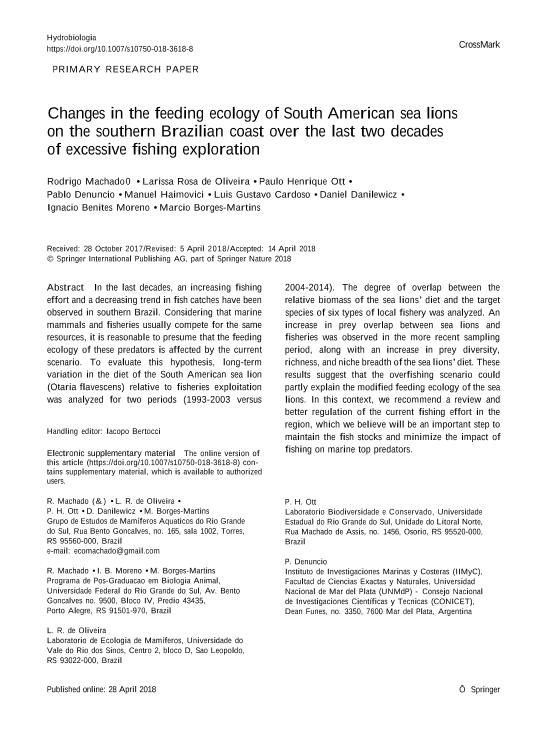Artículo
Changes in the feeding ecology of South American sea lions on the southern Brazilian coast over the last two decades of excessive fishing exploration
Machado, Rodrigo; Rosa de Oliveira, Larissa; Ott, Paulo Henrique; Denuncio, Pablo Ezequiel ; Haimovici, Manuel; Cardoso, Luis Gustavo; Danilewicz, Daniel; Moreno, Ignacio Benites; Borges-Martins, Márcio
; Haimovici, Manuel; Cardoso, Luis Gustavo; Danilewicz, Daniel; Moreno, Ignacio Benites; Borges-Martins, Márcio
 ; Haimovici, Manuel; Cardoso, Luis Gustavo; Danilewicz, Daniel; Moreno, Ignacio Benites; Borges-Martins, Márcio
; Haimovici, Manuel; Cardoso, Luis Gustavo; Danilewicz, Daniel; Moreno, Ignacio Benites; Borges-Martins, Márcio
Fecha de publicación:
09/2018
Editorial:
Springer
Revista:
Hydrobiologia
ISSN:
0018-8158
Idioma:
Inglés
Tipo de recurso:
Artículo publicado
Clasificación temática:
Resumen
In the last decades, an increasing fishing effort and a decreasing trend in fish catches have been observed in southern Brazil. Considering that marine mammals and fisheries usually compete for the same resources, it is reasonable to presume that the feeding ecology of these predators is affected by the current scenario. To evaluate this hypothesis, long-term variation in the diet of the South American sea lion (Otaria flavescens) relative to fisheries exploitation was analyzed for two periods (1993–2003 versus 2004–2014). The degree of overlap between the relative biomass of the sea lions’ diet and the target species of six types of local fishery was analyzed. An increase in prey overlap between sea lions and fisheries was observed in the more recent sampling period, along with an increase in prey diversity, richness, and niche breadth of the sea lions’ diet. These results suggest that the overfishing scenario could partly explain the modified feeding ecology of the sea lions. In this context, we recommend a review and better regulation of the current fishing effort in the region, which we believe will be an important step to maintain the fish stocks and minimize the impact of fishing on marine top predators.
Archivos asociados
Licencia
Identificadores
Colecciones
Articulos(IIMYC)
Articulos de INSTITUTO DE INVESTIGACIONES MARINAS Y COSTERAS
Articulos de INSTITUTO DE INVESTIGACIONES MARINAS Y COSTERAS
Citación
Machado, Rodrigo; Rosa de Oliveira, Larissa; Ott, Paulo Henrique; Denuncio, Pablo Ezequiel; Haimovici, Manuel; et al.; Changes in the feeding ecology of South American sea lions on the southern Brazilian coast over the last two decades of excessive fishing exploration; Springer; Hydrobiologia; 819; 1; 9-2018; 17-37
Compartir
Altmétricas



